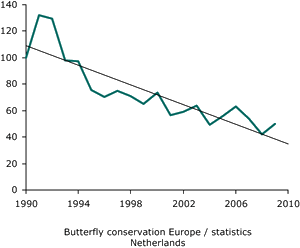Farming intensity and biodiversity

Farming in Europe ranges from the most intensive production systems, typically on more fertile land, to very low-intensity, more traditional landuses, usually found on poorer land. The differences in intensity are enormous. Nitrogen inputs range from none to several hundred kg/ha/year, arable yields from less than 1 t/ha to over 10 t/ha, olive yields from less than 0.5 t/ha to over 8t/ha, and livestock densities from as low as 0.1 Livestock Units (LU) per hectare, to 5 LU or more.
Biodiversity is higher on farmland that is managed at a low intensity
A more intensive application of machinery, fertilisers, biocides and livestock reduces the opportunities for wildlife on cropped and grazed land. At the same time, intensive use of farmland tends to eliminate features such as field margins and uncultivated patches.

At the lowest end of the intensity spectrum, the productive land itself supports a range of wildlife species, especially when it includes a high proportion of semi-natural1 pasture. Low-intensity farming of this sort covers extensive areas of Europe’s more marginal regions, and the future of many of our most valued habitats and species depends on these large areas continuing under such use. The term High Nature Value farming was coined to emphasise this crucial role of low-intensity farming in European biodiversity conservation (Baldock et al. 1993).
Not only intenification is a severe threat to agricultural biodiversity. Especially in marginal, remote areas, abandonment is the most important problem. In the European Alps, 40 % of all farm holdings were abandoned in the period 1980–2000 (Tasser et al. 2007, in EEA 2010).
Examples of areas with HNV farming can be found in our HNV Showcases and the HNV Panoramas. The “Focus on...” series contains more in-depth knowledge on different species & habitats typical for these sites. We plan to present new examples on a regular basis.
A more extensive list of possible HNV farming bird and butterfly species from the EU Guidance document (IEEP 2007) can be downloaded below.
1 Semi-natural vegetation is naturally occuring (not planted) grass, scrub or woodland that is grazed and/or cut on a regular basis, resulting in a state that mimics natural habitats.
2 EEA (2010): Assessing biodiversity in Europe — the 2010 report. Chapter 3.5, Copenhagen
